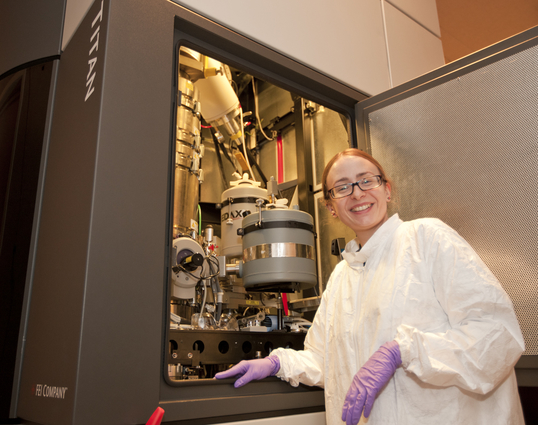Postdoc to continue micrometeorite research through Marie Curie Fellowship
 (Download Image)
While at LLNL, postdoc Penny Wozniakiewicz used the Titan electron microscope to analyze samples. Photo by Jacqueline McBride/LLNL
(Download Image)
While at LLNL, postdoc Penny Wozniakiewicz used the Titan electron microscope to analyze samples. Photo by Jacqueline McBride/LLNL
Wozniakiewicz , a postdoc who has been working in the Lab's Institute of Geophysics and Planetary Physics, was recently awarded the prestigious Marie Curie Fellowship under the International Incoming Fellowships (IFF) scheme of the European Commission on Research and Innovation. She will be expanding upon the research she has conducted with Lab scientists John Bradley and Hope Ishii for the past three years at the Natural History Museum in London.
Her new project will study and compare previously unanalyzed micrometeorites, with the goal of developing a new understanding of the conditions that existed during the early solar system. "Micrometeorites, like the larger meteorites, originate from comets and asteroids -- the small bodies of our solar system," Wozniakiewicz explained. "Some of these are thought to have remained pristine since they first formed, while others may have experienced heating and held liquid water during their lifetime.
"Since the structure or composition of a material can be indicative of the environment or process by which it formed, for example, some minerals can only form above or below certain pressures and temperatures, or in the presence or absence of certain elements, the study of meteorites and micrometeorites can provide a wealth of information on the formation and evolution of our solar system," she continued.
Micrometeorites sample a much greater number of parent bodies since larger meteorites have a lower probability of collection. "If you take two rocks, keep one as a single sample and smash the other one to pieces and put both materials in orbits around the sun, the probability of sampling pieces from the one that was broken up is much greater than it would be to collect the solid sample," she said.
However, much less research has been done on micrometeorites because their small size has made isolating and analyzing them more challenging.
One of the key sample sets of micrometeorites that will be studied were collected by Wozniakiewicz on Kwajalein Island, part of an atoll in the Marshall Islands, under a NASA grant. The remote location of Kwajalein is particularly advantageous to the collection of micrometeorites.
Wozniakiewicz said that although micrometeorites contribute an estimated 10,000 to 50,000 tons of extraterrestrial material to the Earth each year, in most locations the background terrestrial dust vastly outnumbers the incoming micrometeorites, completely obscuring them. On Kwajalein, located in the Pacific Ocean and more than 1,000 miles from the nearest continent (and associated dust), the background dust is heavily reduced.
Using air sampling equipment much like that used at the Lab site, the tiny particles less than one-ten-thousandth of a meter in diameter that bombard the earth from space, are collected onto filters that appear to resemble cling-wrap. Collecting micrometeorites directly from the atmosphere, before they reach the ground, also dramatically reduces the amount of terrestrial background particles as only terrestrial particles made airborne can dilute the collection. The collection process which takes one week per sample will continue on Kwajalein through June.
While at LLNL, Wozniakiewicz used state-of-the art analytical instrumentation, including the Titan field emission gun (FEG) monochromated scanning transmission electron microscope (STEM), to analyze samples.
Wozniakiewicz, who hails from the United Kingdom, earned her Ph.D. from Imperial College London, and has her sights set on academia, teaching at a university where she can work with both students and other researchers in the laboratory.
She left the United States for the United Kingdom in early February but found the opportunities at LLNL "amazing." "The state of the art equipment here -- such as the Titan -- is awesome. I am extremely privileged to have had the opportunity to use it," she said.
Contact
Linda A Lucchetti[email protected]
925-422-5815
Tags
Academic EngagementPostdocs
Science
Featured Articles







